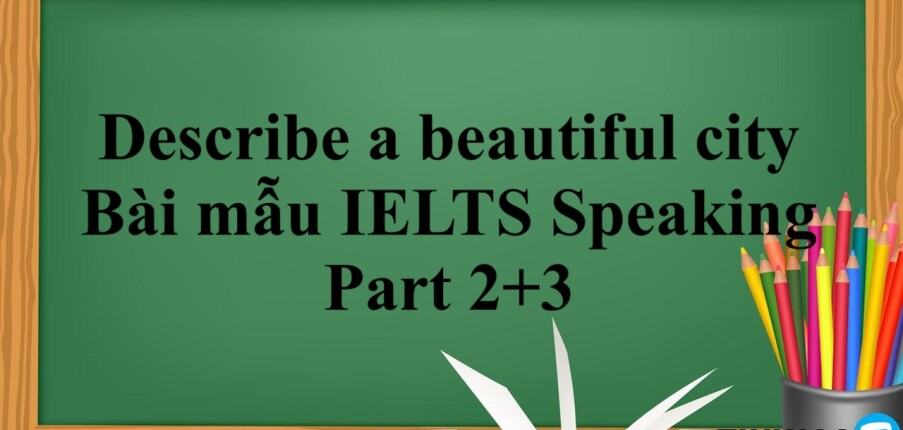Describe a beautiful city | Bài mẫu IELTS Speaking Part 2+3
Bài mẫu chủ đề Describe a beautiful city
Describe a beautiful city.
You should say:
- where the city is
- how you know about the city
- what it is famous for
And explain why you think this city is beautiful.
Dàn ý
- Situation - I'd like to talk about a charming place in my country, Vietnam, known as Hoi An..
- Task - Describe where it is, how you know it, what special features it has, and explain why you think it is interesting.
- Action - Provide information about Hoi An's location, how you became familiar with it, highlight its unique characteristics, and express your reasons for finding it fascinating.
- Result - Share a comprehensive description of Hoi An and your personal reasons for considering it an interesting place.
Bài mẫu 1
Well, there's this captivating place in Vietnam called Hoi An. It's a picturesque town located in the central part of the country, in Quang Nam province, along the banks of the Thu Bon River.
I got to know about Hoi An through recommendations from friends who had visited, and I was also drawn to it by the enticing images I saw online. Hoi An is often referred to as the "City of Lanterns" due to its famous lantern-lit evenings and its well-preserved ancient town.
One of the most outstanding features of Hoi An is its beautifully preserved architecture from the 15th to the 19th century. The town is a UNESCO World Heritage Site and is known for its charming yellow buildings with intricate wooden details. Walking through the old town feels like stepping back in time, and the lantern-lit streets at night create a magical atmosphere.
Hoi An is also famous for its tailoring shops. It's a paradise for those looking to get custom-made clothing at affordable prices. The skilled tailors can create anything from traditional Vietnamese ao dai to modern suits, and the quality is exceptional.
What makes Hoi An even more intriguing is its cultural diversity. The town has a mix of Vietnamese, Chinese, and Japanese influences, which is reflected in its architecture, cuisine, and traditions. You can explore ancient temples, sample delicious local dishes, and even participate in traditional lantern-making workshops.
What I find most interesting about Hoi An is its unique blend of history, culture, and natural beauty. The town has managed to preserve its heritage while also embracing modern tourism. Whether it's strolling along the river, trying local delicacies at the night market, or simply taking in the serene ambiance, Hoi An has a special charm that is hard to resist.
And that’s all I wanna share. Thanks for listening!
Từ vựng cần lưu ý
- Picturesque town (Thị trấn đẹp như tranh): Mô tả một thị trấn có cảnh quan đẹp và thú vị.
- Enticing images (Hình ảnh hấp dẫn): Các hình ảnh thu hút và đáng chú ý.
- Charming (Đáng yêu): Mô tả một địa điểm hoặc người có sự hấp dẫn và cuốn hút.
- UNESCO World Heritage Site (Di sản thế giới UNESCO): Mô tả một địa điểm được UNESCO công nhận vì giữ lại giá trị văn hóa, lịch sử, hoặc tự nhiên đặc biệt.
- Charming (Đáng yêu): Mô tả một địa điểm hoặc người có sự hấp dẫn và cuốn hút.
- Intricate (Tinh xảo): Mô tả sự phức tạp và tinh xảo trong thiết kế hoặc chi tiết.
- Custom-made clothing (Quần áo may đo): Quần áo được làm theo yêu cầu và đo kỹ càng.
- Cultural diversity (Sự đa dạng văn hóa): Sự khác biệt và đa dạng trong văn hóa và truyền thống.
- Local delicacies (Đặc sản địa phương): Các món ăn ngon địa phương.
- Embracing modern tourism (Chào đón du lịch hiện đại): Sự thích nghi và chấp nhận du lịch đương đại.
- Special charm (Sức hấp dẫn đặc biệt): Mô tả sự cuốn hút độc đáo và đặc biệt của một địa điểm.
Bài mẫu 2
I’ve had the pleasure of visiting many beautiful cities, but Hanoi, Vietnam, holds a special place in my heart. I had the opportunity to visit this charming city last summer during a backpacking trip through Vietnam.
Hanoi is a captivating blend of old and new. The Old Quarter, with its narrow streets and traditional tube houses, offers a glimpse into Vietnam's rich history. I spent hours wandering through this historic district, admiring the local artisans at work and sampling delicious street food.
One of the highlights of my trip was visiting the Temple of Literature, Vietnam's first university. The serene atmosphere and beautiful architecture made it a perfect place to escape the bustling city. I was also impressed by Hoan Kiem Lake, a picturesque lake located in the heart of the city. Every evening, locals would gather around the lake to enjoy the cool breeze and the stunning views of the city skyline.
What I love most about Hanoi is the warmth and hospitality of its people. The locals were always friendly and eager to help, making me feel right at home. I also appreciated the city's vibrant culture, which was evident in the numerous festivals and traditional performances that I attended.
In conclusion, Hanoi is a truly beautiful city that has a special place in my heart. Its rich history, unique culture, and friendly people make it a must-visit destination for anyone traveling to Vietnam.
Từ vựng ghi điểm:
- holds a special place: giữ một vị trí đặc biệt
- backpacking trip: chuyến du lịch bụi
- captivating blend: sự pha trộn, kết hợp hấp dẫn
- offers a glimpse into: cái nhìn thoáng qua
- serene atmosphere: không khí yên bình
- Bustling: nhộn nhịp
- Picturesque: đẹp như tranh vẽ
- vibrant culture: văn hóa sôi động
- Must-visit: phải ghé thăm
IELTS Speaking Part 3 Sample – Cities and Buildings
1. What are the differences between modern towns and modern cities?
The distinctions between modern towns and cities lie in their size and complexity. Modern cities are larger and more densely populated than towns. They offer a broader range of amenities, services, and employment opportunities. Cities typically have advanced infrastructure, while towns may have a more intimate and community-oriented atmosphere.
- Distinctions: sự khác biệt, sự phân biệt
Example: The distinctions between the two smartphone models are evident in their features and price points. (Sự khác biệt giữa hai mẫu điện thoại thông minh này thể hiện rõ ràng ở các tính năng và mức giá của chúng.)
- Densely populated: dân cư mật độ cao
Example: Some urban areas are densely populated, with high-rise apartment buildings dominating the skyline. (Một số khu vực đô thị có dân số mật độ cao, với các tòa nhà chung cư cao tầng nổi bật trên bầu trời.)
- Community-oriented: tập trung vào cộng đồng
Example: The neighborhood association organizes community-oriented events to strengthen bonds among residents. (Hội cư dân khu phố tổ chức các sự kiện tập trung vào cộng đồng để củng cố mối quan hệ giữa cư dân.)
Sample 1: When it comes to the differences between modern towns and cities, one major factor is the size and population. Cities are generally larger and more populated than towns. What’s more, cities tend to have more advanced infrastructure, diverse economic activities and a wider range of amenities and services compared to towns. In addition, the pace of life in cities is often faster, while towns may offer a more tranquil and more laid-back atmosphere.
- Infrastructure (n): cơ sở hạ tầng
- Amenities (n): những tiện nghi và tiện ích
- Tranquil (adj): im ắng và yên bình
- Laid-back (adj): thư giãn, thoải mái
Sample 2: Well, there are some that I could mention.
First, cities have a larger area in general and therefore, a higher population density, with more diverse age groups and people from different cultures and languages. On the contrary, towns are sparsely populated and tend to be less diverse in terms of race, customs, and so on.
Second, cities are almost always highly urbanized, with skyscrapers and high-rises, whereas towns can retain some natural features even though they’re modernized, like fields or hills.
Third, cities tend to have a larger economy size, and consequently, more job opportunities. Don’t get me wrong, there’s still employment in towns but it’s nowhere near the level that cities have.
- urbanized: đô thị hoá
- natural features: đặc điểm tự nhiên
- employment: chỗ làm
2. Why do some people like to visit historical sites?
Many individuals are drawn to historical sites due to their intrinsic cultural and educational value. These sites offer a window into the past, allowing people to connect with history, learn about different eras, and appreciate the architectural and artistic achievements of bygone times. Visiting historical sites also fosters a sense of heritage and identity.
- Intrinsic: bản chất, cốt lõi
Example: The intrinsic beauty of the artwork lies in its attention to detail and use of vibrant colors. (Vẻ đẹp bản chất của tác phẩm nghệ thuật nằm ở sự chú ý đến chi tiết và việc sử dụng màu sắc sặc sỡ.)
- Cultural and educational value: giá trị văn hóa và giáo dục
Example: Museums are places of cultural and educational value, where visitors can explore art, history, and science. (Bảo tàng là những nơi mang giá trị văn hóa và giáo dục, nơi khách tham quan có thể khám phá nghệ thuật, lịch sử và khoa học.)
- Architectural and artistic achievements: thành tựu về kiến trúc và nghệ thuật
Example: The ancient temple is a testament to the architectural and artistic achievements of its time. (Ngôi đền cổ xưa là một minh chứng cho những thành tựu về kiến trúc và nghệ thuật của thời đại của nó.)
Sample 1: People are drawn to historical sites for various reasons. Primarily, visiting historical sites allows individuals to connect with the past and gain insights into different cultural practices, traditions, and historical events. It provides a tangible link to history, fostering a sense of appreciation and understanding. Additionally, historical sites often possess architectural beauty and offer a unique atmosphere that captivates visitors, making the experience both educational and compelling.
- Draw (v) somebody to something: thu hút ai đó tới cái gì
- Gain insights into: đạt được những hiểu biết hoặc những cái nhìn sâu sắc về
- Cultural practices: những thực hành văn hóa
- Tangible (adj): rõ ràng, có thể cảm nhận được
- Foster (v): nuôi dưỡng
- Captivate (v): thu hút, hấp dẫn ai đó (= fascinate)
- Compelling (adj): very attractive and interesting (= fascinating = captivating)
Sample 2: Well, I think it’s out of a sense of duty and respect to their culture and history. Some historical sites are places where major battles took place, in which their ancestors fought off invaders and secured independence. Many people visit those sites as a way to pay tribute to our forefathers and thank them for the sacrifices they made. It’s also a way for them to contribute to the conservation of those sites and landmarks. The more tourists visit those places, the more funds are available to help maintain historical landmarks.
- sense of duty: ý thức trách nhiệm
- independence: Sự độc lập
- pay tribute to: Vinh danh
3. How can people preserve historic cities and historic buildings?
Preservation of historic cities and buildings involves maintaining their structural integrity, protecting them from environmental damage, and ensuring their cultural significance is retained. This can be achieved through meticulous restoration, conservation efforts, and strict zoning regulations that prevent incompatible development.
- Structural integrity: tính kết cấu
Example: The earthquake-resistant design ensured the structural integrity of the skyscraper during the tremor. (Thiết kế chống động đất đảm bảo tính kết cấu của tòa nhà cao tầng trong suốt cơn động đất.)
- Environmental damage: thiệt hại môi trường
Example: Pollution from factories can cause severe environmental damage to nearby ecosystems. (Ô nhiễm từ nhà máy có thể gây ra thiệt hại môi trường nghiêm trọng cho các hệ sinh thái gần đó.)
- Cultural significance: ý nghĩa văn hóa
Example: The ancient temple holds great cultural significance for the local community and is a place of reverence and tradition. (Ngôi đền cổ xưa mang ý nghĩa văn hóa lớn lao đối với cộng đồng địa phương và là nơi của sự tôn kính và truyền thống.)
- Meticulous: tỉ mỉ, kỹ lưỡng
Example: The artist's meticulous attention to detail is evident in every brushstroke of the painting. (Sự chú ý tỉ mỉ của nghệ sĩ đọng trong từng nét vẽ của bức tranh.)
Sample 1: Preserving historic cities and buildings requires a collective effort. Firstly, strict conservation laws and regulations need to be in place to prevent unauthorized alterations or demolitions. Secondly, financial incentives, such as tax breaks or grants, can encourage property owners to invest in restoration and maintenance. Public awareness-raising campaigns are also crucial to emphasize the cultural and historical value of these sites, fostering a sense of responsibility within the community.
- Collective (adj): chung, tập thể
- Unauthorized alterations or demolitions: những sự chỉnh sửa hoặc phá dỡ trái phép
- Financial incentives: những ưu đãi về tài chính
- Tax breaks: những khoản khấu trừ thuế
- Tax grants: những khoản trợ cấp thuế
- Restoration and maintenance: sự phục hồi và bảo trì
- Public awareness-raising campaigns: những chiến dịch nâng cao ý thức cộng đồng
Sample 2: First and foremost, by being respectful visitors. Many historical landmarks have suffered from acts of vandalism like people writing on historical artifacts or littering everywhere. These actions should be called out by respectful visitors and heavily fined. People could also make financial contributions to preserve those sites. The contribution doesn’t need to be huge; it just needs to come from the heart, and any amount of money would help maintain those sites.
- vandalism: sự phá hoại
- contribution: sự đóng góp
4. Is it the government's responsibility to preserve historic cities and historic buildings?
Preservation is a shared responsibility, but governments play a crucial role due to their ability to enforce regulations and allocate resources. Governments can create policies, provide funding, and establish legal frameworks to safeguard historic areas. However, collaboration between the government, private sector, and the community is often necessary for effective preservation.
- Shared responsibility: trách nhiệm chung
Example: Protecting the environment is a shared responsibility that requires cooperation from individuals, communities, and governments. (Bảo vệ môi trường là một trách nhiệm chung đòi hỏi sự hợp tác từ cá nhân, cộng đồng và chính phủ.)
- Enforce regulations: thực thi quy định
Example: Law enforcement agencies are responsible for enforcing traffic regulations to ensure road safety. (Các cơ quan thực thi pháp luật chịu trách nhiệm thực thi các quy định giao thông để đảm bảo an toàn đường bộ.)
- Allocate resources: phân bổ nguồn lực
Example: The government allocates resources to improve healthcare infrastructure in underserved communities. (Chính phủ phân bổ nguồn lực để cải thiện hạ tầng chăm sóc sức khỏe trong các cộng đồng thiếu hỗ trợ.)
- Legal frameworks: khung pháp lý
Example: Legal frameworks for intellectual property protection help encourage innovation and creativity. (Khung pháp lý về bảo vệ sở hữu trí tuệ giúp thúc đẩy sự sáng tạo và đổi mới.)
Sample 1: While individuals and private organizations play a role, the primary responsibility for preserving historic cities and buildings falls on the government. Governments can enact and enforce preservation laws, allocate funds for restoration projects, and establish agencies dedicated to cultural heritage protection. They serve as custodians, ensuring that these sites are maintained for future generations to appreciate.
- Fall on (phrasal verb): (khi nói về trách nhiệm) thuộc về
- Enact (v): thông qua (một đạo luật)
- Enforce (v): đảm bảo rằng mọi người chấp hành một đạo luật hoặc quy tắc, thực thi
- Allocate funds: cấp vốn
- Cultural heritage: di sản văn hóa
- Custodian (n): người trông nom
Sample 2: Definitely, without a shadow of a doubt. Maintaining historical sites can be a costly endeavor. Besides financial resources, it also takes expertise to maintain the quaint, historical appearance of buildings while keeping its structure strong, and only the government has the capabilities to undertake this. However, the responsibility shouldn’t fall on the government alone. The public should play a part as well.
- without a shadow of a doubt: không một chút nghi ngờ
- a costly endeavor: một nỗ lực tốn kém
- undertake: đảm nhận
5. Does historic preservation contradict economic development?
Historic preservation does not inherently contradict economic development. In fact, it can stimulate economic growth through heritage tourism, job creation in restoration projects, and increased property values. However, finding a balance between preserving historic character and accommodating modern development can be challenging but is essential for sustainable growth.
- Inherently: về bản chất, theo bản chất
Example: Freedom of speech is inherently protected by the constitution as a fundamental right. (Quyền tự do ngôn luận được bảo vệ theo bản chất bởi Hiến pháp như một quyền cơ bản.)
- Contradict: mâu thuẫn, trái ngược
Example: Her actions contradict her words, as she had previously promised to support the project. (Hành động của cô trái ngược với lời nói, vì cô đã hứa hỗ trợ dự án trước đó.)
- Heritage tourism: du lịch di sản
Example: Many historic cities rely on heritage tourism as a significant source of income. (Nhiều thành phố lịch sử dựa vào du lịch di sản như một nguồn thu nhập quan trọng.)
- Restoration projects: dự án khôi phục
Example: The restoration project aimed to revitalize the old theater and bring it back to its former glory. (Dự án khôi phục nhằm hồi sinh nhà hát cũ và đưa nó trở lại vị thế xưa kia.)
Sample 1: Historic preservation does not necessarily contradict economic development; in fact, they can complement each other. Preserving historical sites can attract tourism, leading to economic benefits for local communities. Adaptive reuse of historic buildings for commercial purposes, such as restaurants or boutique shops, can contribute to economic revitalization while preserving the cultural and architectural heritage of a place.
- Complement (v): bổ sung, bù đắp
- Adaptive (adj): có khả năng thay đổi khi cần thiết, mang tính thích ứng
- Boutique shop: một cửa hàng nhỏ chuyên bán quần áo, trang sức hoặc những món quà đắt tiền
- Economic revitalization: sự hồi sinh về kinh tế
Sample 2: Not necessarily. Historical monuments and landmarks could serve as tourist attractions that bring in visitors, which means business for local establishments. A case in point would be Dien Bien Phu fortress in Vietnam, which attracts thousands of visitors every year who want to see where the French was defeated by a small but strong country in Southeast Asia. The development of tourism to this landmark also brings customers for restaurants and hotels in the region, contributing to its economy and giving people there a stable livelihood.
- Historical monuments: Di tích lịch sử
- landmarks: các địa danh
- local establishments: cơ sở địa phương
- livelihood: kế sinh nhai
6. What do you think will happen to historic buildings and places in the future? Why?
In the future, the fate of historic buildings and places will depend on the commitment of societies and governments to preservation. While some may face challenges due to neglect or urbanization pressures, concerted efforts can ensure their survival. Continued recognition of their cultural and economic value is key to their preservation, but proactive measures are necessary to secure their future in an ever-changing world.
- Concerted efforts: sự nỗ lực đồng lòng
Example: The community made concerted efforts to clean up the local park and make it more inviting for visitors. (Cộng đồng đã thể hiện được sự nỗ lực đồng lòng để dọn dẹp công viên địa phương và làm cho nó hấp dẫn hơn đối với du khách.)
- Recognition: sự nhận biết, sự công nhận
Example: The artist received recognition for her outstanding contributions to the world of contemporary art. (Nghệ sĩ được công nhận vì đóng góp xuất sắc của cô vào thế giới nghệ thuật đương đại.)
- Proactive measures: biện pháp chủ động
Example: Implementing proactive measures to reduce carbon emissions is essential for combating climate change. (Thực hiện biện pháp chủ động để giảm khí thải carbon quan trọng để chống biến đổi khí hậu.)
Sample 1: The fate of historic places and buildings in the future depends on the commitment of societies to their preservation. With increasing awareness of cultural heritage importance, there is hope for continued efforts in restoration and conservation. However, urbanization and development pressures may pose challenges. Sustainable development practices and a balance between modernization and preservation will be key to ensuring that historic places endure for generations to come.
- Fate (n): vận mệnh
- Pose challenges: đưa ra những thách thức
- Sustainable (adj): bền vững, không gây hại môi trường
- Endure (v): tiếp tục tồn tại (continue to exist for a long time)
Sample 2: Well, I believe that they would continue to stand the test of time and serve as important reminders of the past. The government has done a great job at preserving them, and I think this will definitely continue in the future, as they have significant historical and cultural values.
- stand the test of time: đứng trước thử thách của thời gian
Xem thêm các tài liệu Tiếng Anh hay, chi tiết khác:
TOP Việc làm "HOT" dành cho sinh viên:



